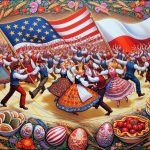
The 20th century was a turbulent time for Poland, with the impact of world wars, the fight for independence, and lots of social and political changes.
Because of this, Polish paintings from this time are more than just art. They tell the story of Poland’s difficult history. These paintings show us Poland’s search for its own identity, how its people kept going despite the challenges, and how they held onto their traditions even as the modern world changed everything around them.
By looking at these paintings, we can learn a lot about how art and history are connected and think about how they still affect us today.
The Impact of World Wars
The World Wars profoundly impacted 20th-century Polish painting, transforming both its themes and styles. These global conflicts changed how Polish artists thought about and portrayed the world around them. They moved away from traditional ways of painting to explore deeper, more personal themes like human suffering, existential fear, and the unbreakable human spirit. This shift was significant. Before, art was more about showing things as they were; now, it was about expressing feelings and experiences that were hard to put into words.
Artists turned to abstract expressionism, surrealism, and symbolism to capture the essence of their experiences during the wars. These styles allowed them to use colors, shapes, and symbols to represent the complex emotions and trauma caused by the wars, something that realistic depictions couldn’t fully convey. For example, the use of distorted figures or surreal landscapes could evoke the disorienting effect of war on individuals and societies in ways that traditional portraits or landscapes couldn’t.
This transformation in Polish painting wasn’t just about art for art’s sake. It was a response to the dramatic changes in the world and in Poland itself. The wars had caused massive social, political, and personal upheavals, and artists were trying to make sense of these changes through their work. They were asking big questions about human nature, suffering, and survival, and they were using their canvases to explore these questions in new and innovative ways.
In doing so, Polish painters redefined what national art could be. Rather than simply depicting the Polish landscape or historical events, they were now reflecting on the human condition in a way that was both deeply personal and universally relatable. This shift not only changed the direction of Polish art but also contributed to a broader conversation in the art world about the role of art in society and the ways in which it can help us understand and process our experiences.
To truly appreciate the impact of the World Wars on Polish painting, one could look at the works of artists like Stanisław Ignacy Witkiewicz or Władysław Strzemiński. Their art captures the tumultuous emotions and shifting realities of their time, offering a window into the profound changes that were taking place in Polish society and in the hearts of its people. Through their paintings, we can begin to understand how these global conflicts reshaped not just a nation’s art but also its identity and its understanding of the human experience.
Independence and Identity
The impact of the World Wars on Polish painting highlights a significant period of introspection and expression among Polish artists concerning their country’s independence and identity. During this time, artists faced the harsh reality of a divided nation and used their art to articulate a growing sense of what it means to be Polish. They increasingly incorporated folk motifs and historical subjects into their works. These elements did more than remind people of their common history; they boldly declared the ongoing existence and strength of Polish culture despite political turmoil.
For example, paintings from this era often depict scenes or characters that are deeply symbolic of Poland. Artists might blend national icons, key historical figures, and landscapes that shout ‘Poland’ in every brushstroke. This trend in art wasn’t just about reflecting the mood of the times; it was a purposeful effort to keep Polish culture alive and assert the nation’s right to independence and its unique identity in a world that seemed intent on tearing it apart.
This artistic movement, therefore, stands as a powerful testament to the resilience of the Polish spirit. It wasn’t just about creating beautiful images; it was about making a statement, reaffirming Polish independence and identity in a way that words alone could not. Through their art, these artists contributed to the cultural fabric of their country, ensuring that despite the challenges of their era, the essence of Poland remained vibrant and unmistakable.
Social and Political Turmoil
In the 20th century, Polish art vividly reflected the country’s social and political upheavals. This era saw Poland grappling with the effects of World Wars, fighting against foreign control, and seeking its national identity amid constantly changing borders. Polish artists played a crucial role during these challenging times, using their art to express both the turmoil and resilience of their people. Their artwork acted as a powerful tool, showcasing the struggle for freedom and the enduring spirit of the Polish people.
For example, the works of artists like Jacek Malczewski and Stanisław Wyspiański highlight the intense nationalistic fervor and the deep longing for independence. Malczewski’s paintings, laden with symbolic imagery, depict Poland’s mythical and historical figures, wrestling with the chains of oppression. Wyspiański, on the other hand, focused on the beauty of Polish landscapes and folklore, reminding the people of their rich cultural heritage amidst foreign rule.
These artists’ contributions went beyond mere expressions of personal angst or despair. They offered a visual narrative of Poland’s fight for sovereignty, capturing the collective memory and identity of a nation in flux. Their art served as a reminder of the past struggles and a beacon of hope for future generations, emphasizing the importance of resilience and unity in the face of adversity.
Moreover, the evolution of Polish art during the 20th century serves as an educational tool, offering insights into the complex history and cultural dynamics of Poland. It provides a unique perspective on how art can influence and reflect societal changes, making it relevant not only to art enthusiasts but to anyone interested in understanding the power of creative expression in shaping national identity.
Folk Traditions and Culture
In the 20th century, as Poland navigated through various socio-political challenges, its folk traditions and culture played a crucial role in shaping the nation’s artistic landscape. There was a noticeable revival of interest in rural life and folklore. Artists started to explore and celebrate themes related to peasant life, folklore, and the untouched beauty of the Polish countryside. These elements were not just for art’s sake; they symbolized Polish identity and resilience against the rapid changes brought by modernity.
Artists like Józef Chełmoński and Stanisław Masłowski are perfect examples. They paid close attention to details, colors, and forms in their paintings, highlighting the simplicity and authenticity of Polish folk traditions. Their works are more than just paintings; they are a celebration of Poland’s spirit and cultural heritage. Through their art, these motifs served as a reminder of the country’s enduring identity amidst the century’s upheavals.
This focus on folk culture and traditions provided a different perspective on the Polish experience. It suggested a narrative of continuity, of holding on to one’s roots and values despite the changes and challenges of the times. In a way, these artistic endeavors helped to preserve the essence of Polish culture for future generations, showcasing the importance of tradition in maintaining national identity.
For anyone interested in exploring this rich cultural heritage, visiting museums dedicated to Polish art and history, or attending traditional folk music and dance performances, can be enlightening. These experiences offer a window into the soul of Poland, reflecting the enduring love for tradition and the natural beauty of the Polish landscape.
Artistic Movements and Innovations
In the 20th century, Polish artists made a big impact by mixing their country’s folk traditions with new artistic ideas. This blend of old and new created a special style that made Polish art stand out. For instance, artists like Stanisław Wyspiański and Józef Mehoffer took symbols and themes that were important in Poland and combined them with Symbolism, a popular art style of the time. This mix gave their work a unique Polish flavor.
Then, there was a group of artists who really wanted to shake things up. Tytus Czyżewski and Leon Chwistek were at the forefront of this movement, known as Formism. They were all about breaking the rules of traditional art to explore new ideas like abstraction and expressionism. Their work wasn’t just about creating something different; it was a response to the changing world around them, reflecting the political and social upheavals of their time.
These movements weren’t just a big deal in Poland; they put Polish artists on the map in Europe. By daring to mix the old with the new and pushing the boundaries of what art could be, these artists showed a kind of bravery and creativity that was admired far and wide.
Talking about these artists and their work isn’t just a history lesson. It’s a reminder of the power of creativity and how daring to be different can lead to something truly remarkable. Whether you’re an art enthusiast looking to explore the rich tapestry of Polish art or a student studying European art movements, the legacy of these Polish artists offers a wealth of inspiration. Their story is a testament to the enduring spirit of innovation and the impact of blending tradition with new ideas.
Conclusion
20th-century Polish paintings give us a clear picture of what life was like back then. They show how the World Wars, the fight for independence, and big social and political changes affected the country.
These paintings also celebrate Polish traditions and culture. Artists of that time were not just creating art; they were telling stories of struggle, hope, and change.
Their work helps us understand the strength and transformation of Poland through tough times, all while pushing art in new directions. It’s like a history lesson, but through the eyes of those who lived it.






Comments are closed.